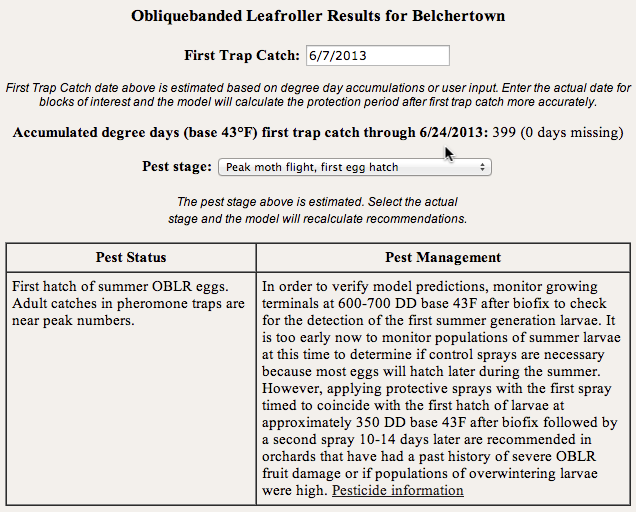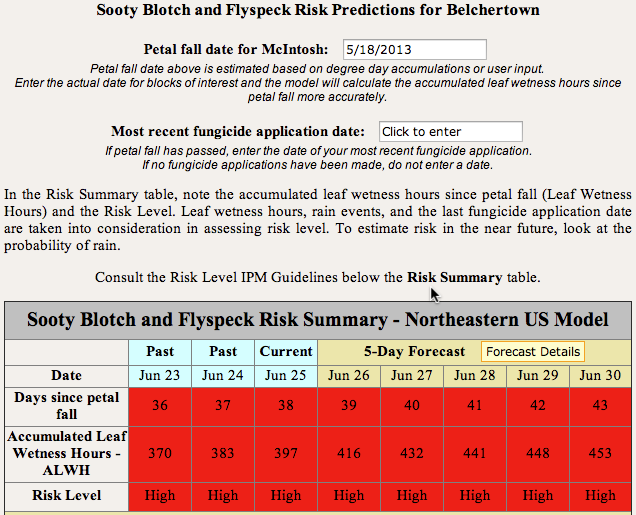

Current degree day accumulations
Orchard radar apple insect key dates
MFGA 2013 Summer Meeting
Location: UMass Cold Spring Orchard, Belchertown, MA
24-June, 2013 |
|
| Base 43 | 1232 |
| Base 50 | 820 |
| Coming events | Degree days (Base 43) |
| Pear psylla 2nd brood hatch | 967-1185 |
| Oblique-banded leafroller 1st flight peak | 826-1208 |
| Oblique-banded leafroller summer larvae hatch | 1038-1460 |
| San Jose scale 1st flight subsides | 851-1233 |
| San Jose scale 1st generation crawlers present | 1033-1215 |
| Lesser appleworm 1st flight subsides | 990-1466 |
| Apple maggot 1st catch | 1243-1663 |
| Oriental fruit moth 2nd flight begins | 1286-1510 |
| Redbanded leafroller 2nd flight begins | 1252-1580 |
Here are insect key insect dates from Orchard Radar, Belchertown, MA.
Codling moth (CM) 1st generation, first sustained trap catch biofix date: May 16, Thursday. Codling moth development as of June 25: 1st generation adult emergence at 96% and 1st generation egg hatch at 70%. In most orchards, insecticide targeted against plum curculio and apple maggot prevent codling moth damage. If targeted codling moth control is needed, key management dates are: 1st generation 20% CM egg hatch: June 14, Friday = target date for first spray where one spray needed to control 1st generation CM.
Obliquebanded Leafroller (OBLR) 1st generation OBLR flight begins around: June 8, Saturday. Where waiting to sample late instar OBLR larvae is not an option (= where OBLR is known to be a problem, and will be managed with insecticide against young larvae): Early egg hatch and optimum date for initial application of B.t., Delegate, Proclaim, Intrepid, Rimon, Altacor, Belt, pyrethroid or other insecticide effective against OBLR (with follow-up applications as needed): June 24, Monday. Optimum sample date for late instar summer generation OBLR larvae: July 2, Tuesday. If first OBLR late instar larvae sample is below threshold, date for confirmation follow-up: July 6, Saturday.
Plum curculio (PC) earliest safe date for last PC insecticide spray: June 8, Saturday. If relying on repellance by Surround instead of PC mortality by insecticide, Surround coverage should be maintained until PC egglaying begins to naturally decline around Thursday, June 27.
Spotted tentiform leafminer (STLM) 2nd flight begins around: June 17, Monday. Rough guess of when 2nd generation sap-feeding mines begin showing: July 4, Thursday. Optimum sample date for 2nd generation STLM sapfeeding mines is July 11, Thursday.
European Red Mite (ERM) Optimum monitoring period for 3rd ERM generation is: Tuesday, June 25 (nymphs hatched) to Sunday, June 30 (egglaying starts for 4th generation).
http://extension.umass.edu/fruitadvisor/upcoming-events
WEDNESDAY, July 10, 2013: Summer Meeting of the Mass. Fruit Growers' Association in cooperation with the University of Massachusetts Fruit Program, Honey Pot Hill Orchards, 138 Sudbury Rd., Stow, MA. 10 AM to 2:30 PM. For meeting flyer and registration info, click here: http://massfruitgrowers.org/2013/2013summermeeting.html. Or you can fill out and mail the form attached at end of this week's HF.
Rain, rain go away, 7 plus inches in the past 30 days at Belchertown. More elsewhere I suspect. I feel sorry for anyone still battling scab, and there is no end to the rain in sight in the 7-10 day forecast. So, where does that lead me? -- disease issues including apple scab, brown rot on ripening stone fruit, fabraea leaf spot in pears, and now summer diseases must all still be on our minds. And what about fire blight? Has anyone seen much? I have not had any reported, but savvy growers treated with streptomycin during bloom. If you do have blight in your orchard, and you get a windstorm with rain and/or hail with you better be on top of it with streptomycin. Insect-wise, the only thing that seems worth treating right now is oblique banded leafroller (OBLR) as the timing is perfect to apply such hi-tech insecticides as Delegate, Altacor, Belt, Proclaim, Rimon, etc. for this pest. After seeing potato leafhopper nearly a month ago in one southern Massachusetts orchard, I have not seen any yet in Belchertown. Where are they? Can we wait until after July 4 to hang apple maggot traps? Have you voted today? Oh, and I would be watching for mite build-ups and treat as necessary. We have very good miticides to choose from, just consult the 2013 New England Tree Fruit Management Guide.
Don't forget to register for the 2013 Summer Meeting of the Massachusetts Fruit Growers' Assoc. on July 10 at Honey Pot Hill Orchards (Andrew Martin and family) in Stow, MA. You can sign up on the Mass. Fruit Growers' Assoc. website: http://massfruitgrowers.org/. Or you can fill out and mail the form attached at end of this week's HF.
This last week in June is traditionally the timing for a targeted application to treat the egg-hatching stage of oblique-banded leafroller (OBLR) and this year is right on track according to the degree-day model and the NEWA website:

Please consult the 2013 New England Tree Fruit Management Guide for spray/control recommendations for OBLR.
I hope everyone (including your all your staff) is on the lookout for Brown Marmorated Stink Bug (BMSB) this year. The UMass Fruit Program has just rolled out a new page on BMSB on the UMass Fruit Advisor, http://extension.umass.edu/fruitadvisor/brown-marmorated-stink-bug. I would appreciate knowing abou any potential sigtings/findings. (Picture would be helpful.)
I am not much of an expert on pear psylla, but I did get a call from at least one grower last week who appears to be struggling with them. According to Mike Fargione in the Hudson Valley, egg and numph numbers of the 2nd generation are particularly high in some pear orchards down there. He says Delegate with a penetrating surfactant would be a good control choice right now, whereas pyrethroid insecticides seem to be having decreasing efficacy. (Pyrethroids do not generally perform well in hot weather either.) I would also suggest that Movento would be a good treatmen choice right now. For more options, see the pear spray table in the 2013 New England Tree Fruit Management Guide.
It's probably time to get serious about summer diseases issues based on the NEWA assessment below. This means fungicide spray intervals of 5-21 days typically from now through harvest depending on the amount of rain received. NEWA has a neat little trick where you can enter your most recent fungicide spray date and will determine the concurrent risk level, however, it depends somewhat on the kind of fungicide used. Orchard Radar perhaps has a better tool for determining how long your fungicide application is good for, however, it is a lot to digest. Suffice it to say for the time being there are three groups of fungicides with decreasing amount of time to wear-off (i.e., sooner re-application will be necessary). They are:

For all fungicide spray options for summer diseases, consult the 2013 New England Tree Fruit Management Guide.
In case you missed it, a repeat of the following four from 2 weeks ago:
UMass Fruit Advisor: http://umassfruit.com
UMass Fruit Notes: http:umassfruitnotes.com
Scaffolds Fruit Journal: http://www.nysaes.cornell.edu/ent/scafolds/
Network for Environment and Weather Applications (NEWA): http://newa.cornell.edu
Follow me on Twitter (http://twitter.com/jmcextman) and Facebook (http://www.facebook.com/jmcextman)
UMass Vegetable & Fruit IPM Network (on Facebook, http://www.facebook.com/umassipmteam)
2013 New England Tree Fruit Management Guide (http://fruit.umext.umass.edu/2013netfmg/)
The next Healthy Fruit will be published on Tuesday, July 9 (in TWO weeks) or thereabouts, 2013. As always feel free to get in touch with any member of the UMass Fruit Team (http://extension.umass.edu/fruitadvisor/team-members) if you have questions or comments.